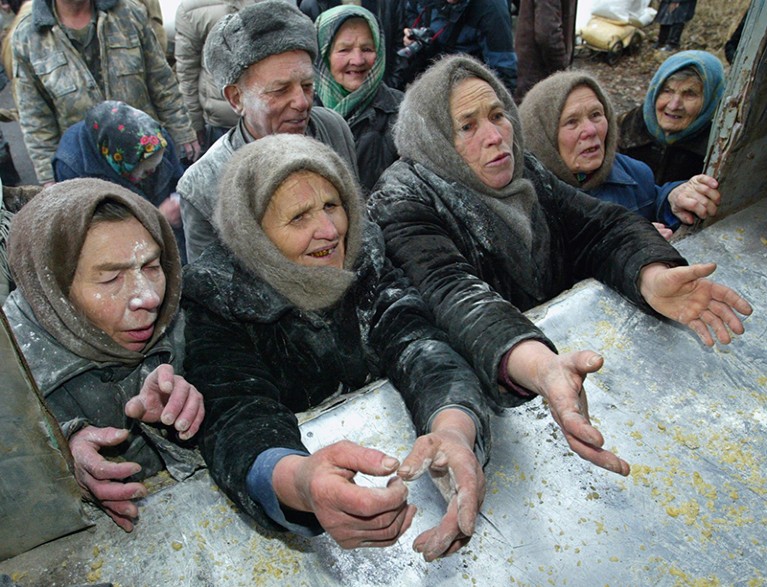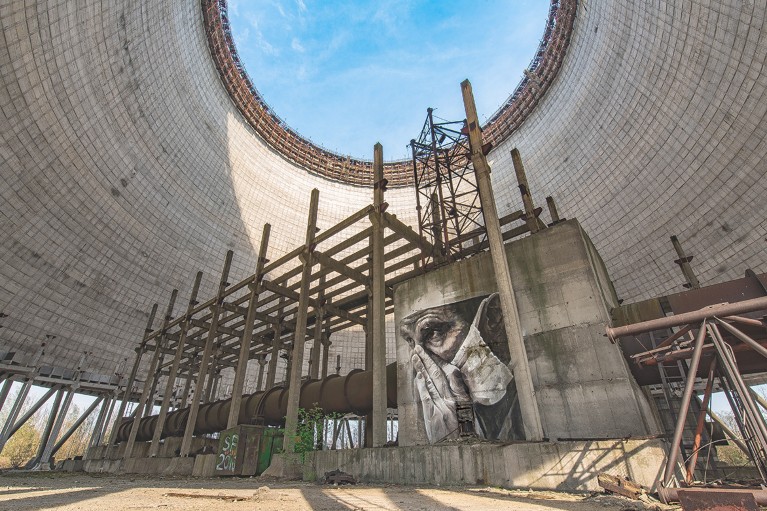Manual for Survival: A Chernobyl Guide to the Future Kate Brown W. W. Norton (2019)
Midnight in Chernobyl: The Untold Story of the World’s Greatest Nuclear Disaster Adam Higginbotham Simon & Schuster (2019)
In the early hours of 26 April 1986, a problem during a scheduled maintenance test set off an uncontrolled nuclear reaction at the Chernobyl power plant in Soviet Ukraine. It rolled on to become the most catastrophic nuclear accident in history: the reactor core of unit 4 was destroyed and surrounding territory massively contaminated. Now, two books on the disaster add fresh perspectives to a vast literature.
In Manual for Survival, historian Kate Brown introduces new archival material to document the public-health crisis — creating a handbook for a “postnuclear reality”. Meanwhile, Midnight in Chernobyl by journalist Adam Higginbotham presents rich first-hand accounts that deepen our understanding of the disaster and its aftermath.
Both suggest that remembering the fears, doubts, errors — and improvised decisions, creative ideas and small successes — of the people involved in Chernobyl would serve us well in bracing for the next disaster.
Brown’s page-turner skilfully weaves an original narrative on the long-term medical effects of the Chernobyl disaster. Today, the official number of fatalities quoted by United Nations agencies ranges from 31 to 54, with another 2,000–9,000 future cancer deaths predicted. Yet in 2005, environmental charity Greenpeace indicated that 200,000 people had already died as a consequence of the disaster, and a further 93,000 fatal cancers were to be expected. A bewildered Brown uses this discrepancy, and our ignorance about it, as a starting point in Manual for Survival. Just as she did in the fascinating Plutopia (2013) — a comparative study of twentieth-century US and Soviet plutonium production plants (M. Peplow Nature 495, 444–445; 2013) — she has unearthed documents never viewed before, and listened to people who have been all but forgotten.
Vowing that she wasn’t “going to fall for every maudlin story”, Brown set out to substantiate and cross-reference her findings. Her work builds on efforts by other scholars, such as Olga Kuchinskaya’s 2014 The Politics of Invisibility and Adriana Petryna’s 2003 Life Exposed. Brown travelled to the forests of Belarus, a wool-processing factory in northern Ukraine, and the exclusion zone surrounding the now mothballed plant at Chernobyl, interviewing, observing, documenting. Her capacity to immerse herself and pick up on nuances brings these stories from factory workers, technicians, doctors and villagers alive.

Women living in the Chernobyl exclusion zone receive food supplies in 2005.Credit: Ivan Chernichkin/Reuters
Brown read official reports on Chernobyl’s health effects, but also local public health statistics; asked researchers to explain their methodology; compared how research protocols were set up and executed. She shows that the myriad studies on Chernobyl-related health effects were rarely coordinated, and their authors often unaware of parallel efforts or previous results.
Brown doesn’t intend to advocate for one set of health-impacts data over another, but “to come to a more certain number describing the damage the accident caused”. She highlights how conflicting data can contribute to an entirely relatable loss of trust in physicians and researchers among those affected by various health woes, from cancers to cardiovascular conditions, whether stemming from Chernobyl or not. The public (all of us) are constantly evaluating numbers according to multiple sets of factors, including credibility, authenticity and engagement of sources.
Conflicting data
After Chernobyl, authorities produced data that consistently conflicted with those of other experts and people’s lived experience; later, the same authorities distanced themselves from their own assessments. When this happens, expertise and impartiality tend to be questioned. Numbers can lie when technicians measure in the wrong places, among the wrong people, at the wrong times. Sociologist Brian Wynne examined this in the case of sheep farmers in Cumbria, UK, in his essay ‘May the sheep safely graze?’ in Risk, Environment and Modernity (1996). The farmers challenged scientific expertise about Chernobyl fallout in the region, on the basis of their knowledge of their flocks and environment.
Brown explores another chilling factor that keeps Chernobyl urgent: the logic of global markets. Its effect can be felt even by people who live far from Ukrainian forests where wildlife, mushrooms and berries remain contaminated. In 2015 alone, Ukraine exported some 19,000 tonnes of fresh and frozen berries to the European market. As Brown documents, radiation-savvy traders pay lower prices for “hot” berries, then mix them with “cooler” berries to meet international trade standards.
Ultimately, Manual for Survival is not a revisionist telling of the Chernobyl accident. Although it goes some way towards documenting a hidden post-Chernobyl public-health crisis, Brown argues that Chernobyl really accelerated a global one. Since 1945, above-ground nuclear weapons tests have spread fallout from the equivalent of 29,000 Hiroshima-sized bombs over the planet.
A focus on Chernobyl and its immediate aftermath, from the perspective of eyewitnesses, is offered in Midnight in Chernobyl. Higginbotham’s tome is based on more than 80 interviews — from scientists to truck drivers, firefighters to doctors, widows to survivors, the majority done on site, with former Soviet citizens involved in the disaster. This is a highly detailed, carefully documented, beautifully narrated telling of this breathtakingly complex accident and its mitigation.
Higginbotham’s handling of the sociopolitical context is also deft. As he tells it, life in the 1970s Soviet Union wasn’t all drab and oppressed: for many, the system offered social mobility, the satisfaction of creating new cities, plants and communities from scratch, and the thrill of being part of a larger social experiment.
His portrayal of the Chernobyl clean-up drives home how crucial effective emergency preparedness is, and just how essential it is to preserve and develop disaster-response expertise. Understanding what exactly is going on during an accident requires scientific and technological judgement. But effective response to a disaster involves much more, including local expertise and tacit knowledge based on experience. Higginbotham shows just how elusive that was, and how much guesswork the response involved at every level — material, technological, scientific, organizational, even psychological. Where did the fuel go? Could there be another explosion? Who should be mobilized — young soldiers or middle-aged reservists?
Along with the chaotic spectacle of intelligent people desperately trying to decide which methodologies to use and when, attempts to contain political fallout were predictable, and eerily similar to Japanese decision-makers’ reactions after the Fukushima Daiichi disaster in 2011. The unfolding narrative ran something like this. We don’t need international assistance. Well, we do; but your technology and methods are incompatible. Who is responsible? We can’t blame the scientific elite for poor design of our flagship reactor. Let’s call it ‘human error’ and blame the operators. And what about the regulator? Shouldn’t they have caught this? You’re fired.
Higginbotham’s book documents a very specific disaster, and by doing so suggests how challenging it will be to respond to a future event. We can perhaps succeed at preparing for another Chernobyl, maybe for another Fukushima, but never for the next unprecedented, mindbogglingly complex, ‘beyond design basis’ accident. Do we, instead, need a manual for survival? And if so, what would one look like?


 Nuclear energy: Meltdowns, redux
Nuclear energy: Meltdowns, redux
 Dinner at the Fission Chips
Dinner at the Fission Chips
 In retrospect: Normal Accidents
In retrospect: Normal Accidents






